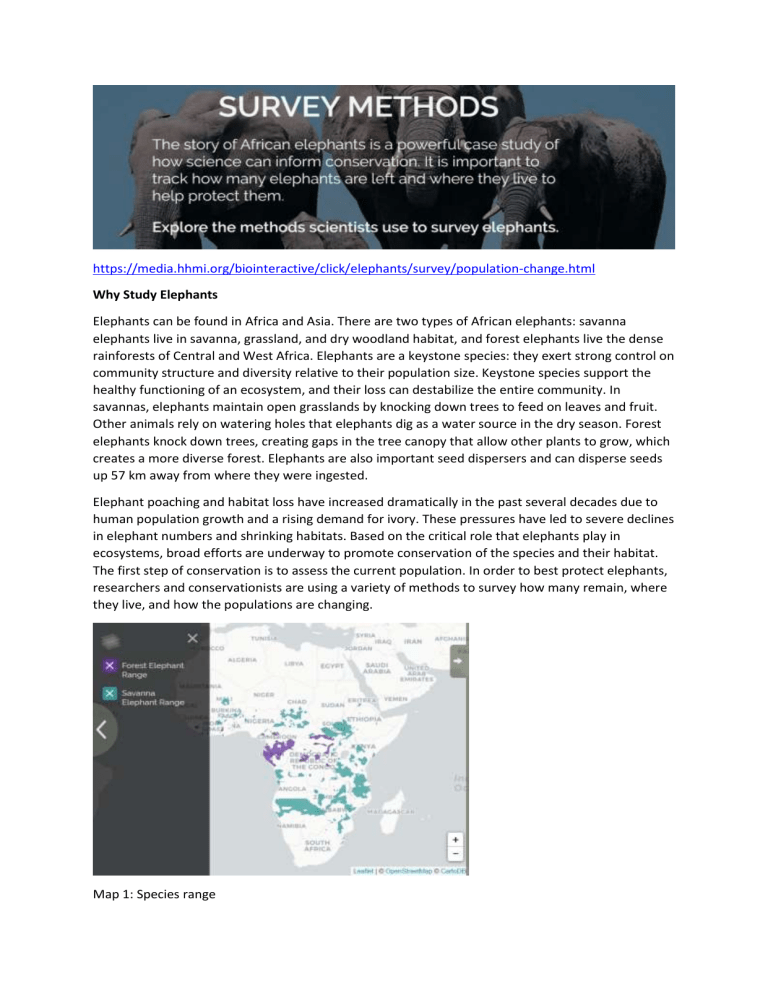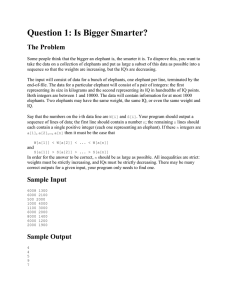
https://media.hhmi.org/biointeractive/click/elephants/survey/population-change.html Why Study Elephants Elephants can be found in Africa and Asia. There are two types of African elephants: savanna elephants live in savanna, grassland, and dry woodland habitat, and forest elephants live the dense rainforests of Central and West Africa. Elephants are a keystone species: they exert strong control on community structure and diversity relative to their population size. Keystone species support the healthy functioning of an ecosystem, and their loss can destabilize the entire community. In savannas, elephants maintain open grasslands by knocking down trees to feed on leaves and fruit. Other animals rely on watering holes that elephants dig as a water source in the dry season. Forest elephants knock down trees, creating gaps in the tree canopy that allow other plants to grow, which creates a more diverse forest. Elephants are also important seed dispersers and can disperse seeds up 57 km away from where they were ingested. Elephant poaching and habitat loss have increased dramatically in the past several decades due to human population growth and a rising demand for ivory. These pressures have led to severe declines in elephant numbers and shrinking habitats. Based on the critical role that elephants play in ecosystems, broad efforts are underway to promote conservation of the species and their habitat. The first step of conservation is to assess the current population. In order to best protect elephants, researchers and conservationists are using a variety of methods to survey how many remain, where they live, and how the populations are changing. Map 1: Species range Survey Design Several methods can be used to survey elephant populations. The appropriate technique for a particular area will depend on the question being asked, the habitat, and resources available to conduct the survey. Each survey method has advantages and disadvantages that researchers must take into account before choosing a method. Animals can be surveyed using direct methods (counting the animals themselves) or indirect methods (counting signs or signals, such as dung, tracks, or sounds). After a method is chosen, the researchers map out the study area, which is the total area they are surveying. If a study area includes several different habitats, such as grassland and forest, or mountains and plains, the study area is divided into strata, or sections, for each habitat. The methods are then adapted to fit the conditions within each stratum. Within each study area or stratum, researchers can choose to perform a total count or a sample count. A total count is when the entire study area is surveyed, while a sample count is when parts of the study area are surveyed and the results from those parts are applied to the entire study area to estimate the total population size. When a sample count is performed, sampling areas can be in the shape of strips, blocks (or polygons), and points. Sampling areas are selected throughout the study area or stratum in either a random or regular fashion. Random sampling is usually preferred because it avoids bias, but in some cases, placing the sampling areas at regular (or equal) intervals is preferred. When sampling in strips, researchers first draw transect lines and the strips are the areas to the right and left of the transect line. Transect lines are typically drawn at regular intervals. Blocks are polygons selected around random points and the entire area within the block is surveyed. A point survey entails stationing an observer, an audio recorder, or a camera at random points in the stratum for a period of time. If researchers are measuring sounds the distance at which sound can be detected around the point determines the area that is being sampled. Dung transects are the most common technique for surveying forest elephant populations. The dense forest vegetation makes it difficult to count elephants directly, so an indirect method, such as counting dung, is necessary. Dr. Fiona Maisels of the Wildlife Conservation Society (WCS) has helped to design and implement survey methods for primates and forest elephants. She and her colleagues gathered data from dung transect surveys performed in five countries in central Africa to estimate the changing sizes of the forest elephant population. Map 2: Dung survey locations for Forest Elephants This method relies on estimating the elephant population size by counting dung piles and knowing how often elephants defecate and how fast dung piles decay. Based on published studies, researchers determined the average rate that elephants defecate: 19.77 dung piles per elephant per day. They gathered information on the time dung takes to decay to the point of disappearance at 14 sites across various habitats and seasons and calculated the average, which was 81.82 days. The survey areas in each of the five countries were divided into strata, and a minimum of 15 transect lines per stratum were regularly placed perpendicular to features such as roads and rivers to avoid sampling bias. Dung transects were performed in one of two ways: the line transect method or the recce method. Line transects – Observers walk along transect lines and measure the perpendicular distance from the transect to the center of each dung pile they observe. Even though the dung piles are distributed over the landscape, they become harder to spot the farther they are from the transect line, decreasing the chance of detection. Modeling software is used to compensate for the missed dung piles and produce a corrected estimate of the total number of dung piles within a maximum distance from the line. Recces – Observers walk along lines and count all dung piles they observe within a 2-meter strip (1 meter on either side of the line). It is assumed that the observers detect all of the dung within the 2 meter strip. The number of elephants in the population was then estimated by modeling. The relationship between elephant density and a number of variables known to affect elephant abundance was calculated using multiple models. The models that best fit the data were chosen, and then, using maps that cover the entire range, the selected models were used to predict elephant density in areas that were not sampled. Advantages When a large enough percentage of the survey area is sampled, dung surveys can be as accurate as other survey methods. They are relatively easy to implement and don't require specialized equipment, but intensive and careful training is required. Elephant dung is easier to detect than the elephants themselves and generates more data than a ground survey of elephants. As dung counts measure dung deposited over time, this method is less sensitive to elephant movement between sampling areas or the clumped distribution of elephants. Disadvantages Dung surveys are extremely time- and labor-intensive, and can be expensive if the survey area is large. This method assumes a stable elephant population creating stable rates of dung accumulation and decay during the study period. Because dung decay times are long, more rapid changes in the elephant population may lead to inaccurate estimates. The rate of dung decay and defecation can also vary with habitat and season. While less clumped than elephants, dung piles are typically not randomly distributed. To avoid inaccurate estimates due to the clumped distribution, the transects need to be arranged throughout all vegetation types in a manner that is representative of the different habitats. It is often advisable to stratify the study area by vegetation type and/or by poaching intensity. A minimum of 30 transects per stratum is advised to improve the precision of estimates. RESULTS Overall four different methods were used to assess how the savannah and forest elephant populations were changing. Combining the four methods you can see the results below. This map shows the entire elephant range in 1979, at the beginning of the ivory crisis. The total estimated elephant population in 1979 was 1.3 million elephants. Almost four decades of habitat loss and illegal poaching for ivory has affected elephant range (savanna and forest elephant combined). It decreased by about half, and due to human land use, much of the remaining habitat is in protected areas. The total estimated elephant population in 2007 was approximately 640,000 elephants. Conservationists can use this information to focus their efforts on protecting elephants that are under threat.






